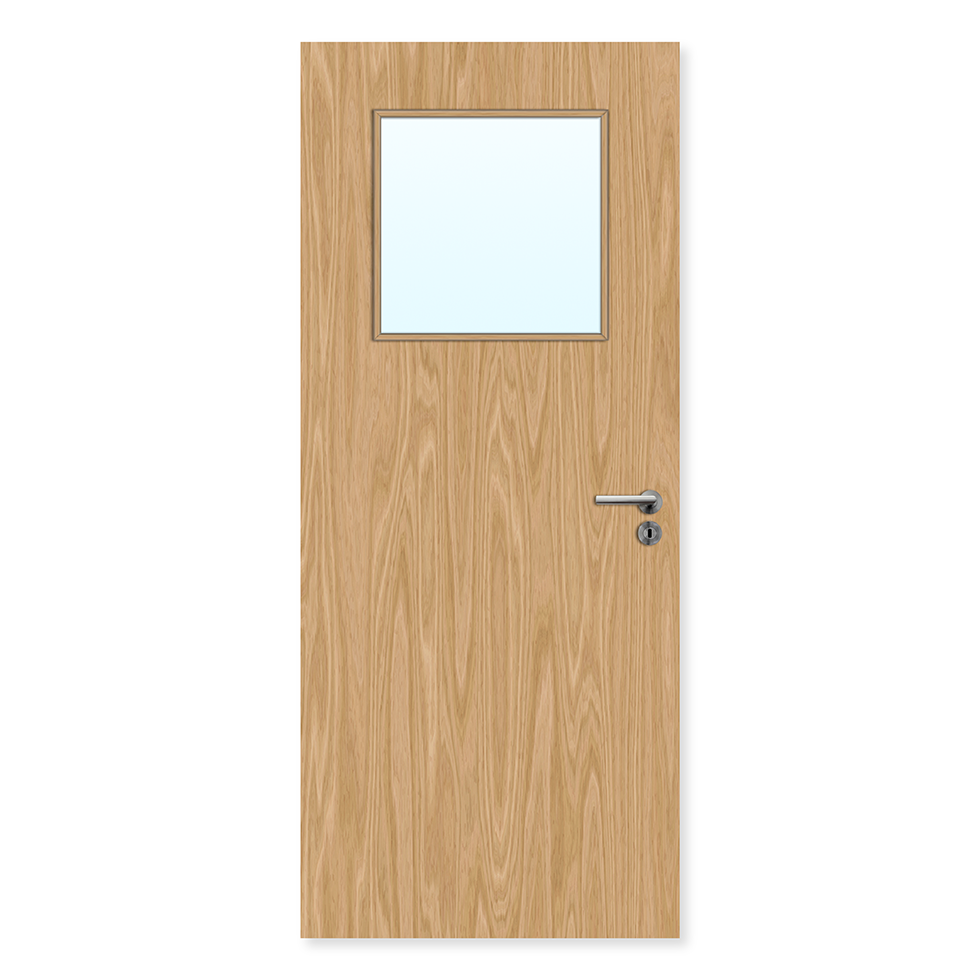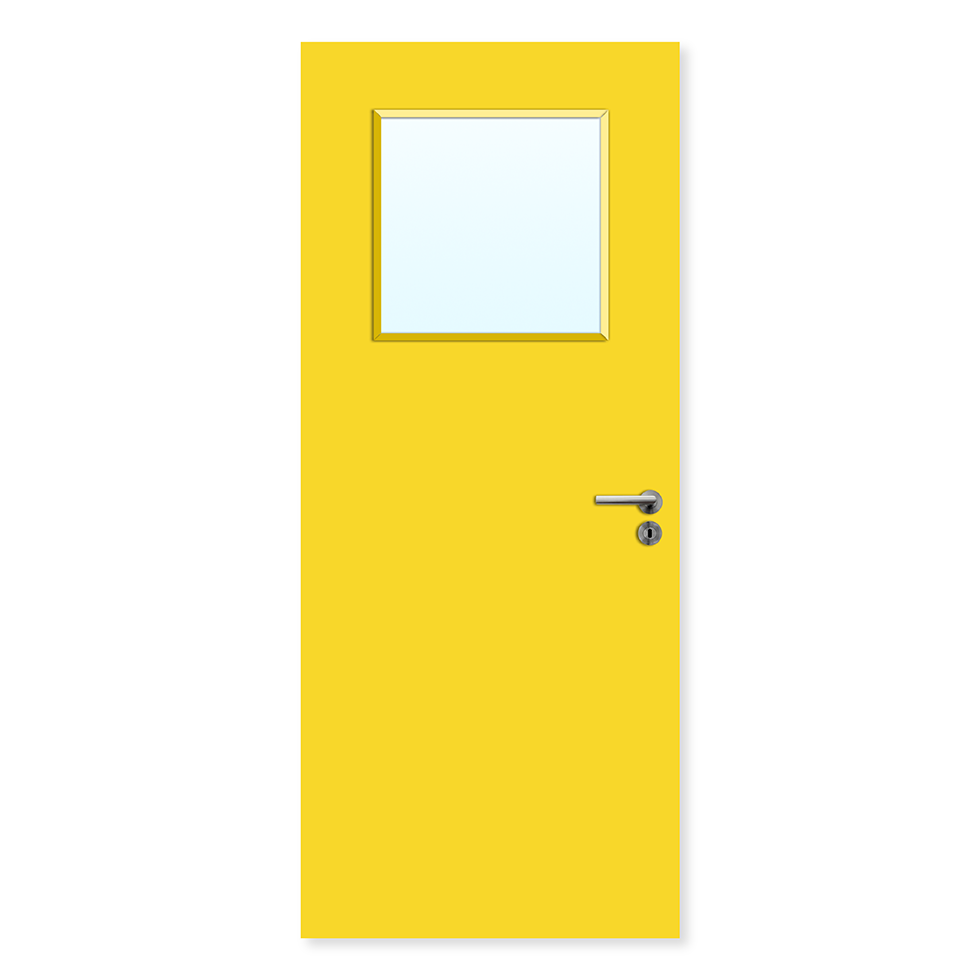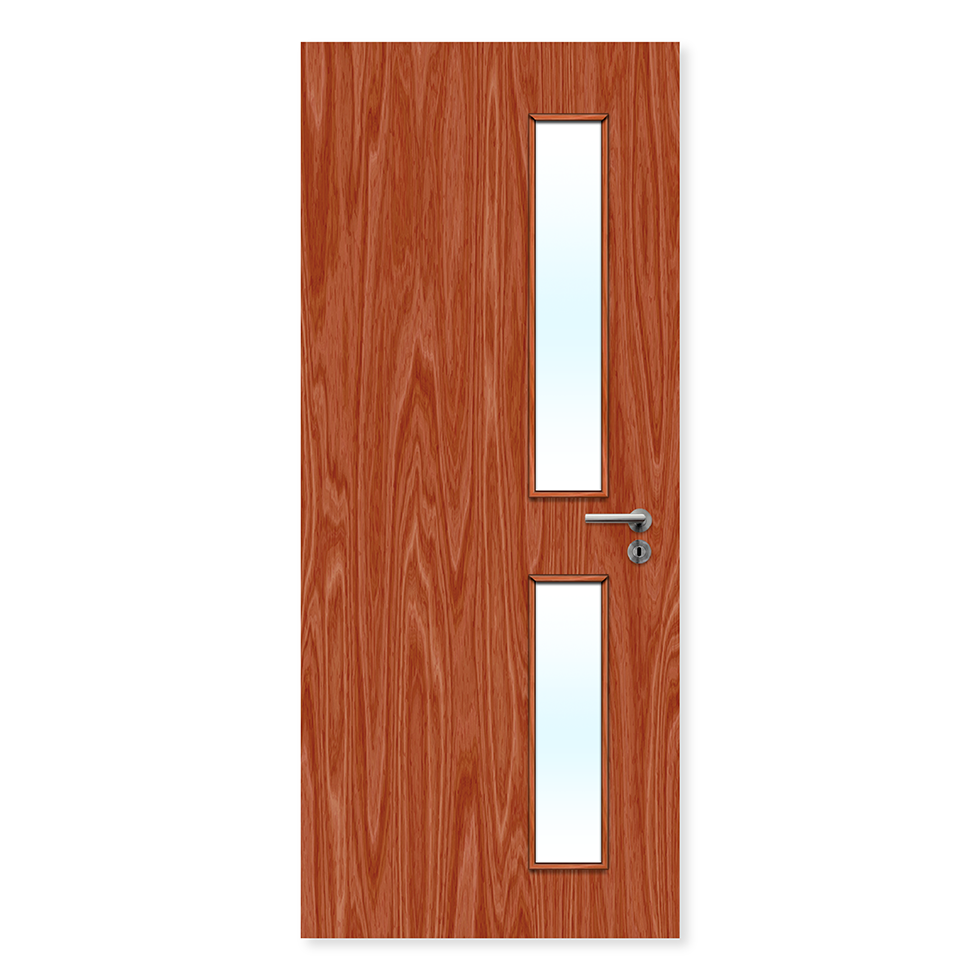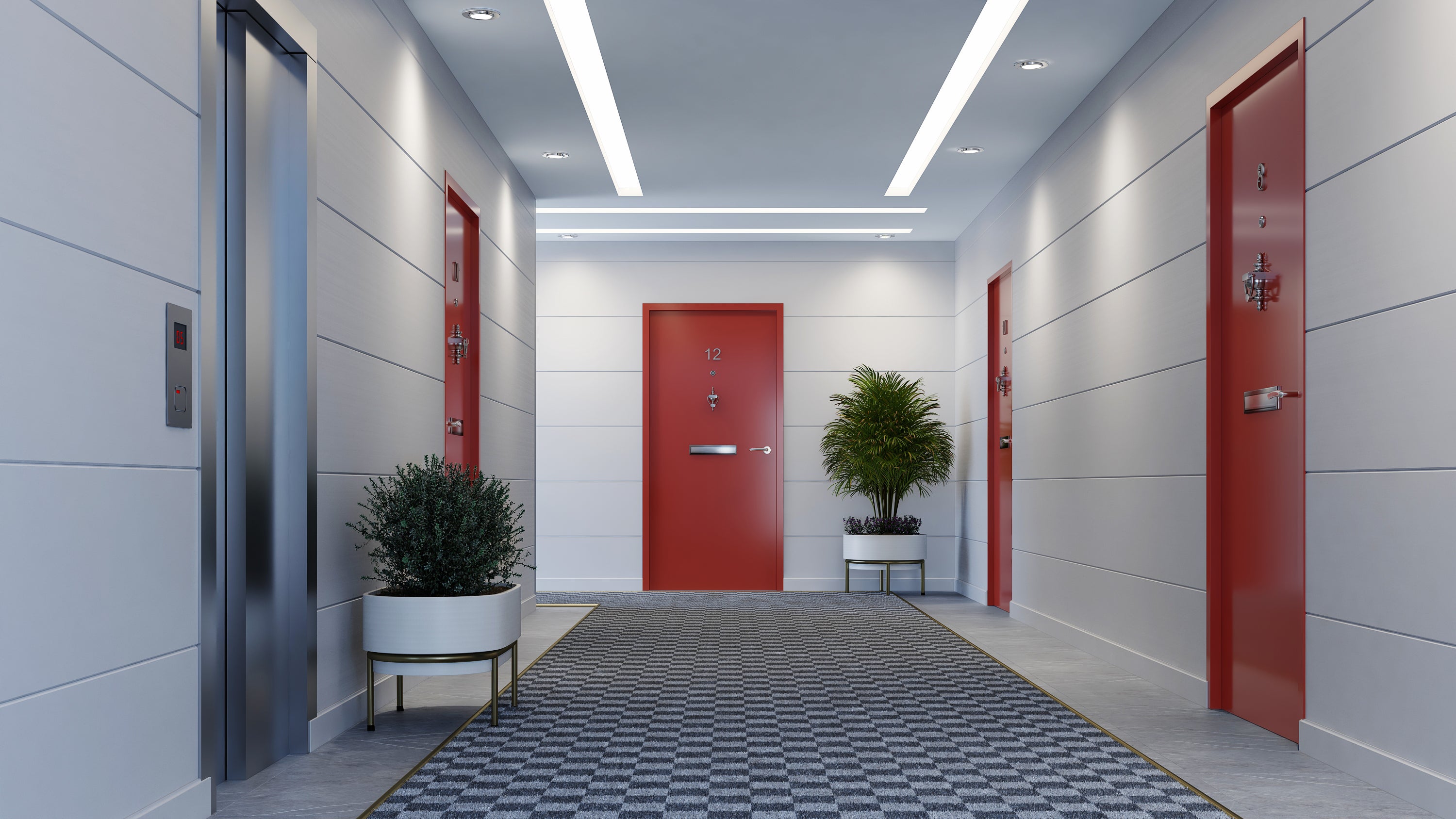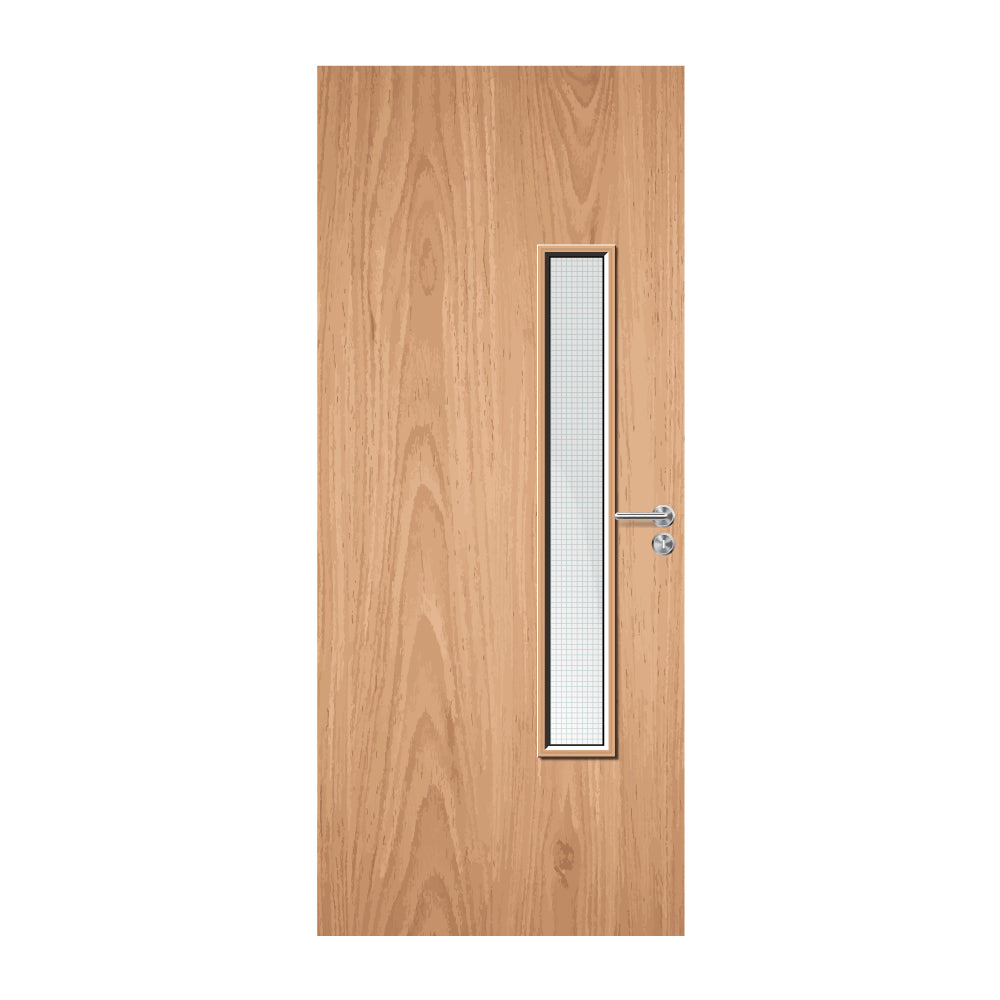Frequently Asked Questions
Got questions? You’ll find answers to common questions below. Browse the tabs to find what you need.
If you still need a hand, please contact us.
What is a fire door and why is it important?
A fire door is a specially constructed door designed to resist the spread of fire and smoke between compartments of a building. Its primary function is to provide occupants with a safe evacuation route and to protect property by containing fire and smoke. Properly installed and maintained fire doors are crucial for effective passive fire protection. See our FD30 and FD60 doors you can get quickly!
What fire resistance levels do you offer in fire doors?
Fire doors are typically either FD30 or FD60 standard. However, there are occasions (which are rare) that either an FD90 or even an FD120 are required. Don't know what you might need? No worries! You can contact us for more details and our team of experts will be happy to help.
Alternatively, you can call us or reach out to us directly via:
Phone: 0330 122 9550
Email: sales@premierfiredoors.com
What's the difference between FD30 & FD60 Fire Door?
FD30 doors offer 30 minute fire protection and is suitable for all domestic situations. FD30's is available in 44mm thickness.
FD60 doors offer 60 minute fire protection, these are available in 54mm thickness and are suitable for higher risk premises and some high risk rooms such as boiler rooms or plant rooms etc.
Which fire door is best for my space?
Before selecting a fire door, it's essential to understand the specific requirements of the space.
In commercial settings, a designated personnel must perform a comprehensive fire risk assessment. This evaluation identifies the necessary locations for fire doors and determines the appropriate fire-resistance ratings based on potential hazards and building layout.
For residential properties, particularly when building new homes or undergoing major renovations. Building Regulations provide clear guidance on where fire doors should be installed to meet legal and safety standards.
Can they be trimmed or cut down?
Yes, but only by the amount permitted by the manufacturer’s instructions and fire door certificate.
What type of glazing can I choose?
All glazing provided by us is fire rated and available in the following finishes:
- Georgian Wired Polished Plate (GWPP) – You can see the wire but it is in clear glass.
- Clear CGI Pyroguard (Clear) – Completely clear.
- Obscure/Frosted (Sandblasted finish to one side) – Clear glass made obscure by sandblasting one face.
Can I paint my door?
You are only able to paint or varnish plywood fire doors with any good quality product.
What about certification?
Certification regarding the conformance with BS476 pt 22 is available on request. Many doors will come with their own unique reference sticker affixed to the top. Please do not remove these.
What components are essential for a compliant fire door?
A compliant fire door assembly includes:
- Door Leaf: The main part of the door, constructed with fire-resistant materials.
- Frame: Must be compatible and fire rated.
- Seals: Intumescent and smoke seals that expand under heat to prevent fire and smoke passage.
- Ironmongery: Certified hardware like hinges, locks, and closers.
- Glazing (if any): Fire-rated glass with appropriate seals.
All components should be tested together to ensure the door's integrity during a fire.
Need guidance? Our team of experts would be happy to help you out! Contact us for more information.
Can I install any hardware on the fire door?
No. Only hardware that has been tested and certified for use with fire doors should be installed. Using uncertified components can compromise the door's fire resistance. For instance, our Zoo Ironmongery offers handles, hinges, locks, and other items, all tested to relevant standards.
How frequently should I replace my fire door?
There’s no fixed rule for when to replace a fire door. It really depends on its condition. Check it at least every six months to make sure it’s working properly. Since fire safety regulations can change, consider having your fire doors inspected by a qualified professional.
How often should fire doors be inspected?
Fire doors should be inspected regularly to ensure they function correctly. While the exact frequency can vary based on local regulations, a general recommendation is:
- Monthly: Visual checks for damage or obstructions.
- 6 Monthly: in accordance with BS9999
- Annually: Comprehensive inspections by qualified professionals.
Regular maintenance ensures the door's effectiveness in an emergency.
Do fire doors need signage?
Yes. Fire doors should have clear signage indicating their purpose. For example: Fire Door Keep Shut (FDKS), Fire door keep locked (FDKL), Fire door keep clear (FDKC)
- "Fire Door Keep Shut": For doors that must remain closed.
- "Fire Door Keep Locked": For doors that should remain locked when not in use, such as electrical riser doors.
Signage should be visible on both sides of the door at approximately 1500mm from floor level.
Can I modify a fire door after installation?
Modifications to fire doors can compromise their integrity. Any alterations, such as adding vision panels or changing hardware, should be done in accordance with the manufacturer's guidelines and tested standards. Unauthorized modifications can void certifications and reduce fire resistance. Any alteration should be carried out by a competent person as defined in the Regulatory Reform (fire safety) Order 2005.
What is the significance of certifications like CERTIFIRE, or BM Trada?
CERTIFIRE and BM Trada are an independent third-party certification scheme that assures the performance and quality of fire protection products. Products with CERTIFIRE or BM Trada certification have been rigorously tested to meet specific fire safety standards, providing confidence in their effectiveness during a fire.
Where can I get assistance with fire door compliance?
You may contact our team of experts, Premier Fire Doors and ask for the Technical Director.
Email sales@premierfiredoors.com for guidance
Do I legally need fire doors in my property?
In most cases, yes. Fire doors are a legal requirement in commercial buildings, multi-occupancy residences (like flats and HMOs), and certain areas such as three-story domestic homes—especially where there’s an integral garage or a loft conversion.
Building regulations outline where fire doors are needed, to slow the spread of fire and protect escape routes.
How do I know if a fire door is certified?
Certified fire doors should carry a visible certification label or plug - typically located on the top edge of the door. This label indicates that the door has been tested to meet fire safety standards, such as BS 476 PT 22 or EN 1634. All fire doors sold by Premier Fire Doors are fully certified and traceable, giving you peace of mind.
What is the difference between a fire door and a regular door?
While they may look similar, a fire door is built with fire-resistant materials and includes crucial components like intumescent seals, self-closing devices, and certified hardware.
These elements work together to delay the spread of flames and smoke. Standard doors simply don’t offer this level of protection in an emergency.
What are the signs that a fire door needs maintenance or replacement?
Fire doors play a critical role in slowing the spread of fire and smoke, so it’s important they remain in top condition. Here are some common signs that your fire door may need maintenance or even replacement:
Signs that maintenance is needed:
- A fire door should shut completely and firmly without sticking or slamming.
- Intumescent or smoke seals around the frame should be intact and securely fitted.
- Hinges must be tight and free of rust or wear. Loose screws or squeaking may indicate an issue.
- There should be consistent gaps—typically 3-4mm—between the door and frame. Gaps that are too wide or uneven may compromise performance.
- Certified fire doors have a label indicating their fire rating. If it’s damaged or missing, the door may need replacement or reassessment.
- Cracks, warping, or visible impact damage could prevent the door from sealing properly during a fire.
Signs it may need replacing:
- Any drilling, cutting, or fitting of non-compliant hardware can compromise the integrity of a fire door.
- If the door fails a professional fire door inspection, replacement may be necessary.
- Older doors may no longer meet current fire safety standards, especially if they're beyond recommended service life or regulations have changed.
Regular inspections—ideally every 6 months—are key to ensuring your fire doors stay compliant and fully functional.
Can I choose a fire door that matches my interior design?
Yes, absolutely. At Premier Fire Doors, we offer a wide range of finishes, colours, and glazing options to suit your aesthetic.
Whether you're fitting a traditional oak door or a sleek modern design, we combine safety with style, no compromise required.
What maintenance do fire doors require?
Fire doors should be checked regularly to ensure they’re working properly. This includes inspecting hinges, seals, gaps around the door, and the self-closing mechanism. We recommend a quick monthly visual check, with a more thorough inspection at least every 6 months. If you're unsure, our team can guide you through what to look for.
Can I install a fire door myself?
While it’s possible for experienced tradespeople to install fire doors, we always recommend using someone familiar with fire door regulations and installation standards.
Even a small mistake can reduce the effectiveness of a fire door. We can supply fully pre-hung door sets and provide support for proper fitting.
What is an intumescent seal and why is it needed?
Intumescent seals are fitted into the edges of a fire door or frame. In the event of a fire, they expand under heat to close any gaps, slowing the spread of smoke and flames. Without these seals, even a certified fire door won't perform as intended.
Door Image Guides
Due to some doors being bespoke, an original door image is not possible at present, and a design drawing is provided as a guide.
We're in the process of updating all our images to resolve this issue, so should you need further guidance we shall do our best to provide a better image were possible.
What are intumescent seals, and why are they important?
Intumescent seals are materials that expand when exposed to high temperatures, sealing gaps around the door to prevent the spread of fire and smoke. They are crucial for maintaining the integrity of a fire door during a fire. Products like Zoo Hardware's Universal Intumescent DIN Lock Sets are designed to enhance fire resistance by sealing gaps around locks.
Are fire doors a legal requirement in the UK?
Yes, fire doors are a legal requirement in almost all UK buildings. The only exception is standard two-storey domestic homes. If you own, manage, or are responsible for any other type of property — from flats and HMOs to commercial or public buildings — you must have compliant fire doors installed. Not only is it a legal obligation, but it also protects lives, safeguards property, and ensures your building meets strict fire safety regulations.
Are fire doors solid?
Not all fire doors are completely solid. While some lower-cost options use a lightweight or composite “biscuit-type” core, high-quality fire doors — like the ones we supply — are engineered with tested fire-resistant materials designed to deliver proven performance. What matters most is that the door is fully certified and compliant, giving you reliable protection and peace of mind.
Are fire doors solid wood?
Some fire doors are manufactured with solid wood cores, but not all. What truly matters is not whether a door is “solid wood” but whether it is fully certified and tested to resist fire. At Premier Fire Doors, we only supply doors that meet UK standards and deliver the protection you can rely on.
Are fire doors a legal requirement in flats?
Yes. Flat entrance doors and many internal flat doors must legally be fire-rated. They are essential for protecting lives, slowing down the spread of fire, and ensuring your building meets UK safety regulations. With Premier Fire Doors, you can be confident your doors comply from the moment they’re installed.
Are all your fire door frames hardwood?
Not always. FD30 fire doors are typically supplied with softwood frames, while FD60 doors are paired with hardwood frames for added strength and fire resistance. We’ll always guide you to the right option so your complete door set is fully compliant and certified.
Are fire doors more soundproof?
Standard fire doors aren’t designed to be soundproof, but thicker or specially designed models can improve sound reduction as well as fire safety. If you’re looking for extra acoustic performance, ask our team — we can recommend the right door to meet both safety and comfort needs.
Are fire doors hollow?
Some cheaper fire doors are manufactured with hollow or lightweight cores. However, the real difference is in the certification and fire test results. All doors from Premier Fire Doors are tested, certified, and built to protect, so you know you’re getting the performance you’re paying for.
Can fire doors have glass?
Yes — as long as the glass itself is fire-rated. We supply glazed fire doors that combine visibility and light with full compliance, so you never have to compromise on safety or style.
Can fire doors be painted?
Absolutely. Fire doors can be painted just like any standard door. The only care you need is to avoid painting over the intumescent or smoke seals. With the right finish, you get both safety and a professional look that suits your space.
Can I use fire foam around your composite door sets when installing?
No. Our composite door sets have only been tested with intumescent mastic to seal the frame and maintain certification. Using fire foam would invalidate compliance. For guaranteed performance, always follow the tested installation method.
Can fire doors be wedged open?
No. Wedging a fire door open is illegal. Fire doors must remain closed to do their job: stopping the spread of fire and smoke. If you need them held open for convenience, ask us about approved hold-open devices such as maglocks or Dorgards.
Can fire doors be propped open?
No. Just like wedging, propping a fire door open is unsafe and against the law. Fire doors should only be held open with approved, tested devices.
Can I fit a drop-down seal to my fire door?
Yes, you can. A face-fixed drop-down seal can be installed, or for a neater finish, it can be professionally milled into the bottom of the door. We can guide you to the right option.
Can I have a spy hole fitted to my fire door?
Yes, but it must be done by the fire door manufacturer. This ensures the integrity of the door is not compromised and certification remains valid.
Can I install a letterbox in my fire door?
Letterboxes can only be fitted if carried out by the manufacturer and supplied as a certified fire-rated letterbox unit. DIY installation would invalidate certification, so always choose the tested option.
Can I fix signage to a fire door?
Yes, provided the screws are not too deep. If deeper fixings are needed, they must be coated with intumescent mastic to maintain fire protection. We recommend using certified fire door signs for compliance.
Can fire doors be locked?
Yes. Certain fire doors can be locked. However, they must always be fitted with a lock that can be opened quickly without a key, such as a thumb-turn lock, to allow safe escape.
Can fire doors open inwards in the UK?
Yes, in smaller buildings or where only a few people are present, fire doors may open inward. However, in larger buildings, entertainment venues, or places with high footfall, exit doors must open outward in the direction of escape. All final exit doors must generally open outwards for safety.
Can fire doors be left open?
Only when fitted with an approved hold-open device such as a maglock or Dorgard. Without one, fire doors must remain closed at all times to provide protection.
How do fire doors work?
Fire doors form part of a fire compartment within a building. They’re designed to separate high-risk rooms (like kitchens or boiler rooms) or to protect escape routes such as corridors and staircases. By holding back fire and smoke, they give people more time to escape safely.
How are fire doors made?
Fire doors are typically built with a fire-resistant core, sealed edges, and high-quality finishes. Different core materials — such as Halspan or Flamebreak — are tested to ensure they perform under fire conditions. Every component is chosen to maximise safety and compliance.
How much can I cut off a fire door?
This depends on the core manufacturer’s instructions. Some allow 2–3mm from each side, nothing from the top, and up to 5mm from the bottom. Always check before trimming. If you’re replacing a fire door, we’ll advise you on the correct core type. If you’re trimming an existing door, we cannot confirm compliance without knowing the original core.
How are fire doors rated?
Fire doors are rated by minutes of fire resistance: FD30 (30 minutes), FD60 (60 minutes), FD90 (90 minutes), and FD120 (120 minutes). Choosing the right rating depends on the building’s fire strategy and regulations.
How much do fire doors cost?
Fire doors can start at under £200 for standard models and go up to several thousand pounds for bespoke, glazed, or high-spec FD60 double door sets. Whatever your budget, we can supply fully certified options that balance cost, compliance, and quality.
How often should fire doors be checked?
According to BS9999, fire doors should be checked every 6 months — and at least annually as a minimum. Regular inspections ensure they remain safe, compliant, and ready to perform in the event of a fire.
How do I measure for a replacement fire door and frame?
We’ve created a simple step-by-step guide in our YouTube video on how to measure accurately for replacement fire doors and frames. This ensures your new fire door will fit perfectly and perform correctly.
How long do fire doors last?
With proper installation, maintenance, and regular inspections, fire doors can last a lifetime. The key is making sure they are serviced and kept in good working order.
How often should fire doors be inspected?
Every 6 months is recommended, but inspections should never be less frequent than once per year. Buildings with higher risk or heavier usage may require more frequent checks.
How do you check a fire door?
A basic inspection includes:
- Checking gaps (3–4mm at the sides/top, max 5mm at the base)
- Ensuring the door isn’t warped and closes fully
- Confirming intumescent/smoke seals are in place
- Checking self-closers are working
- Inspecting hinges and hardware
- Looking for fire-rated glass where applicable
- Ensuring signage (“Fire Door Keep Shut”) is fitted
For peace of mind, we recommend using a third-party accredited fire door inspector.
How do you paint fire doors?
Fire doors can be painted with any standard paint. The only caution is to avoid getting paint on the smoke and intumescent seals, as this may affect their performance.
How much are fire doors for flats?
Prices start under £200 for basic internal flat doors, while flat entrance door sets with frames and certified hardware can cost several thousand. All our doors for flats are fully compliant and designed to meet UK regulations.
How do I identify a fire door in the UK?
Look for key features:
- Thickness (44mm for FD30, 54mm for FD60)
- Smoke and intumescent seals around the edges
- Correct signage such as “Fire Door Keep Shut”
- Certification label or plug from the manufacturer
If in doubt, our team can advise you.
What are fire doors designed to do?
Fire doors are designed to hold back fire and smoke within a building, separating fire compartments and protecting escape routes. External fire escape doors are also designed to allow people to exit a building quickly and safely.
What do fire doors do?
They separate fire compartments, protect escape routes, and enclose high-risk areas like kitchens or boiler rooms — giving people more time to escape safely.
What are fire doors made of?
Most fire doors are made of wood, but modern options also include composite materials and steel. The important factor isn’t the material alone, but that the door is fully certified to resist fire.
Why are fire doors used?
Fire doors are used to contain fire and smoke, protect escape routes, and separate high-risk rooms, especially in multi-storey and commercial buildings.
What is a fire door assembly?
A fire door assembly is when the door, frame, and hardware are purchased separately. Each part must have its own certificate of compliance.
What is a door set?
A fire door set is supplied as a complete package — door, frame, and hardware — all certified together under a single certificate.
What are the numbers on glazed fire doors (1G, 2G, 16G, etc.)?
These indicate different glazing style options, helping you choose the right look without compromising safety.
What sizes are fire doors available in?
Standard fire doors typically measure:
- 1981mm high x 762mm or 838mm wide
- 2040mm high x 726mm, 826mm, or 926mm wide
We also offer bespoke sizes, cut from larger cores (2135mm x 915mm, 1220mm x 2440mm, or 2700mm x 915mm). If you need a custom size, our team can help.
Which doors need to be fire rated?
Generally, fire doors should be rated at FD30 or FD60, depending on the level of protection your building requires.
Which fire doors require smoke seals?
All fire doors should have intumescent seals with cold smoke protection, especially in buildings where occupants are sleeping or highly dependent.
When are fire doors required?
Fire doors are required in all UK buildings except standard two-storey houses. Flats, HMOs, public, and commercial buildings must have them installed.
When should fire doors be closed?
Fire doors should remain closed at all times unless fitted with an approved hold-open device.
When should fire doors be locked?
Fire doors inside a building should never be locked unless they can be opened easily without a key in an emergency.
When should fire doors be wedged open?
Never. Wedging a fire door open is illegal and makes it useless in the event of a fire.
When can fire doors be left open?
Only when they are fitted with an approved hold-open device, such as a Dorgard unit.
Where are fire doors required?
Fire doors should be installed to:
- Enclose high-risk rooms (kitchens, boiler rooms, server rooms)
- Protect escape routes
- Separate fire compartments
Where do fire doors usually fail?
Common failure points include poor glazing bead installation, inadequate frame fixing, and incorrect fire-stopping around the frame. That’s why proper installation is critical.
Where are fire doors located in buildings?
Typically across corridors, at staircases, along fire compartment lines, and around high-risk rooms.
Who is responsible for fire doors in flats?
The flat owner is responsible, including the entrance door that leads onto a shared escape route.
Who is responsible for fire doors in general?
The “Responsible Person” named in the Fire Risk Assessment — often the property owner, landlord, or building manager. In HMOs, the landlord is responsible.
Who pays for fire doors in flats?
Costs typically fall on the owner or tenant.
Who fits fire doors?
A competent installer with third-party accreditation (such as FIRAS or BM Trada) should fit fire doors to ensure compliance.
Who can repair fire doors in the UK?
Repairs should also be carried out by accredited professionals with FIRAS or BM Trada certification.
Why should fire doors be kept closed?
To stop fire and smoke spreading between compartments and protect escape routes.
Why should fire doors not be wedged open?
Because wedging disables their safety function, leaving escape routes unprotected.
Do you sell external fire doors?
Yes, we supply certified external fire doors.
Do you sell external fire door frames?
Yes, we also supply external fire door frames.
Do you sell external fire door frames with certified cills?
Currently no. Certified frames with cills have been withdrawn from the market as they were never fully tested. We are waiting on updates from the certification body.
Do you sell double fire doors?
Yes, we supply double fire doors — flush, glazed, or panelled.
Do you sell rebated double fire doors?
Yes, we can produce rebated double fire doors as bespoke orders.
Do you offer an installation service?
Yes, we can connect you with a fully certified, independent installer.
Do you guarantee your fire doors?
Yes. We offer a unique 25-year guarantee, provided the doors are installed and maintained according to the manufacturer’s instructions.
Do your fire doors meet BS 476 Pt22?
Yes, all our doors, frames, and hardware are fully compliant with current UK fire safety regulations, including BS 476 Pt22.

